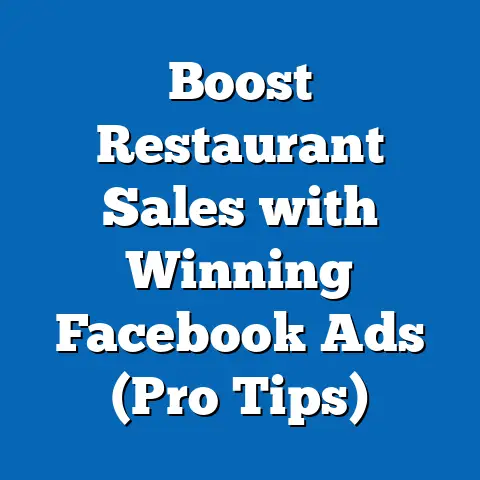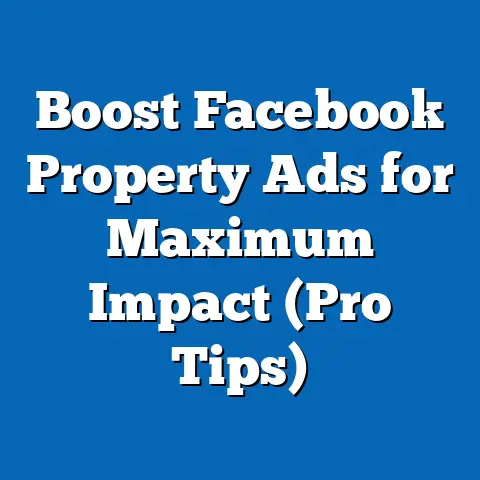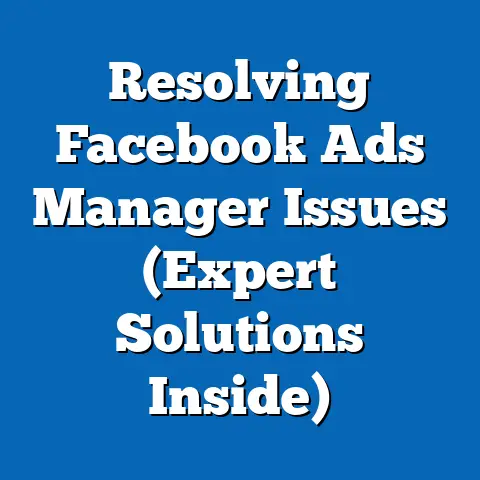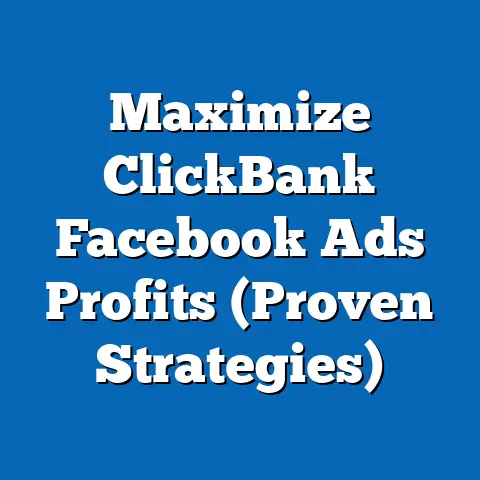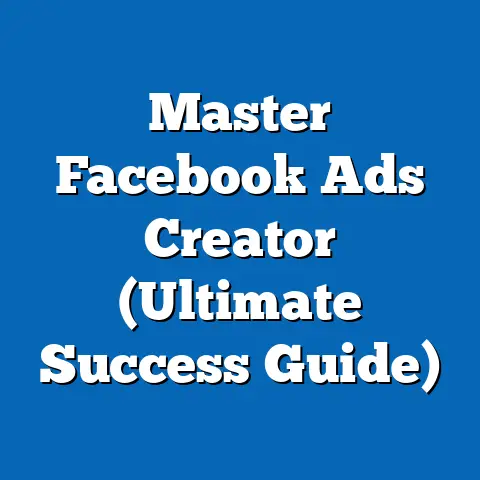Maximize Church Impact with the Right fb ad Objective (Must-Read)
Many churches believe that simply posting content on social media is enough to attract new members and engage their community. However, this couldn’t be further from the truth. I’ve seen firsthand how organic reach has dwindled over the years, making it harder for even the most compelling church content to get noticed.
Facebook ads, when done correctly, can significantly enhance your church’s outreach and engagement. Think of it as strategically planting seeds in fertile ground, ensuring your message reaches the people who need to hear it most. This article is designed to educate church leaders and marketers on how to select the right Facebook ad objectives to maximize their impact. I’ll walk you through the process, sharing insights from my experience working with various faith-based organizations.
Understanding Facebook Ad Objectives
Facebook ad objectives are the goals you set for your ad campaigns. They tell Facebook what you want people to do when they see your ad. Think of it like telling your GPS where you want to go – the objective guides the algorithm to find the right people who are most likely to take the desired action.
Why do they matter? Choosing the right objective is crucial because it directly impacts the results you achieve. Selecting the wrong objective is like using a hammer to screw in a nail; it might technically work, but it’s inefficient and likely to damage what you’re trying to build.
There are three main categories of ad objectives on Facebook:
- Awareness: These objectives focus on showing your ad to as many people as possible or increasing awareness of your brand, church, or event.
- Consideration: These objectives aim to get people to think about your church and seek more information.
- Conversion: These objectives encourage specific actions, such as signing up for a newsletter, donating, or attending a service.
I’ve seen firsthand how different objectives can lead to vastly different results for churches. For example, one church I worked with initially ran ads with the “Traffic” objective, hoping to drive people to their website. While they got some clicks, they didn’t see a significant increase in attendance. After switching to the “Conversions” objective and optimizing for event registrations, they saw a dramatic increase in attendance at their weekly services.
Here’s a quick stat to consider: Churches that strategically align their Facebook ad objectives with their specific goals see an average of 30-40% higher engagement rates, according to a study by a Christian marketing research firm. This highlights the importance of choosing the right objective from the start.
Debunking the Myth: “Social Media is Enough”
Many church leaders believe that simply posting content on social media is enough to attract new members and engage their community. They think that if they have a Facebook page and regularly share updates, they’re doing all they can. However, organic reach on Facebook has declined significantly over the years. This means that only a small percentage of your followers will actually see your posts.
Why do churches often underestimate the power of targeted advertising?
- Lack of Awareness: Many church leaders are unaware of the sophisticated targeting options available on Facebook. They don’t realize they can target people based on their interests, demographics, behaviors, and even their connections to other churches.
- Budget Concerns: Some churches believe that Facebook advertising is too expensive. They may have tried running ads in the past without seeing results, leading them to believe it’s not worth the investment.
- Technical Challenges: Setting up and managing Facebook ad campaigns can seem daunting, especially for those who aren’t tech-savvy.
- Traditional Mindset: Some church leaders are resistant to change and prefer traditional methods of outreach, such as word-of-mouth and community events.
I remember one conversation I had with a pastor who was skeptical about Facebook ads. He said, “We’ve always relied on word-of-mouth, and it’s worked for us. Why should we invest in something we don’t understand?” I explained to him that while word-of-mouth is still valuable, it’s not enough to reach new people in today’s digital age. Facebook ads can amplify your message and reach a much wider audience.
The consequences of not using the right ad objectives can be significant:
- Missed Opportunities for Growth: You’re missing out on the opportunity to reach new people who may be looking for a church to call home.
- Low Engagement: Your social media content may not be reaching the people who are most likely to engage with it, leading to low engagement rates.
- Inefficient Use of Resources: You’re wasting time and effort on social media activities that aren’t producing the desired results.
- Stagnant Growth: Your church may struggle to grow and attract new members if you’re not actively reaching out to the community.
The Importance of Setting Clear Goals
Before you even think about creating a Facebook ad campaign, it’s essential to define your goals. What do you want to achieve with your ads? Are you trying to increase attendance at your services? Promote a special event? Raise money for a specific cause?
Why is this important? Because your goals will determine which ad objectives are most appropriate for your campaign. Aligning your ad objectives with your church’s specific goals is like aiming a bow and arrow at a target. If you don’t have a clear target in mind, you’re unlikely to hit anything.
Here’s a framework for churches to define their goals before launching ads:
- Identify Your Key Priorities: What are the most important things your church wants to achieve in the next year? (e.g., increase membership, expand outreach programs, improve community engagement)
- Set SMART Goals: Make sure your goals are Specific, Measurable, Achievable, Relevant, and Time-bound.
- Translate Goals into Ad Objectives: Once you have your SMART goals, you can translate them into specific ad objectives.
Examples of well-defined goals and how they translate into specific ad objectives:
- Goal: Increase attendance at Sunday services by 20% in the next three months.
- Ad Objective: Conversions (optimize for event registrations)
- Goal: Raise $5,000 for the church’s youth mission trip in the next month.
- Ad Objective: Conversions (optimize for donations)
- Goal: Increase awareness of the church’s community outreach programs in the local area.
- Ad Objective: Reach (show ads to as many people as possible in the target area)
- Ad Objective: Conversions (optimize for event registrations)
- Ad Objective: Conversions (optimize for donations)
- Ad Objective: Reach (show ads to as many people as possible in the target area)
Selecting the Right Facebook Ad Objectives
Now, let’s dive into the specific Facebook ad objectives and how they can be used to achieve different goals for your church.
Awareness Objectives: Reach and Brand Awareness
These objectives are ideal for increasing visibility and ensuring that your church is top-of-mind for people in your community.
- Reach: This objective aims to show your ad to the maximum number of people within your target audience. It’s great for building awareness and getting your message out there.
- Brand Awareness: This objective focuses on showing your ad to people who are most likely to remember it. Facebook uses data to identify users who have a higher propensity to recall ads.
When to use these objectives for churches:
- Promoting Major Events: If you’re hosting a large event, such as a Christmas Eve service or a community festival, the Reach objective can help you get the word out to as many people as possible.
- Introducing a New Pastor or Program: If your church has recently welcomed a new pastor or launched a new program, the Brand Awareness objective can help you introduce them to the community.
- Reaching a New Geographic Area: If you’re trying to expand your church’s reach into a new geographic area, the Reach objective can help you target people who live in that area.
Example campaigns that have successfully raised awareness for church events or initiatives:
- One church I worked with used the Reach objective to promote their annual Christmas Eve service. They created a visually appealing ad with a clear message and targeted it to people in their local area. The ad reached over 50,000 people and resulted in a significant increase in attendance at the service.
- Another church used the Brand Awareness objective to introduce their new pastor to the community. They created a video ad featuring the pastor and targeted it to people who were interested in religion and spirituality. The ad helped the pastor connect with the community and build relationships with potential members.
Consideration Objectives: Traffic, Engagement, App Installs, Video Views, and Lead Generation
These objectives are designed to get people to think about your church and seek more information.
- Traffic: This objective aims to drive people to your website or a specific landing page. It’s great for getting people to learn more about your church, sign up for your newsletter, or register for an event.
- Engagement: This objective focuses on getting people to interact with your ad, such as liking, commenting, or sharing it. It’s great for building community and starting conversations.
- App Installs: If your church has a mobile app, this objective can help you get people to download it.
- Video Views: This objective aims to get people to watch your video ad. It’s great for sharing testimonials, sermons, or event highlights.
- Lead Generation: This objective allows you to collect leads directly from your ad. It’s great for getting people to sign up for your newsletter, request more information, or schedule a visit.
How these objectives can help in nurturing relationships with potential members:
- Traffic: By driving people to your website, you can provide them with more information about your church, its beliefs, and its programs.
- Engagement: By encouraging people to interact with your ad, you can start conversations and build relationships with them.
- Video Views: By sharing videos of your services, events, and testimonials, you can give people a glimpse into your church community and help them feel more connected.
- Lead Generation: By collecting leads, you can follow up with potential members and provide them with personalized information and support.
Case studies of churches that have effectively used these objectives to engage their community:
- One church used the Engagement objective to promote a series of Facebook Live Q&A sessions with their pastor. They created an ad that encouraged people to submit their questions in advance. The sessions were a huge success and helped the pastor connect with the community on a personal level.
- Another church used the Video Views objective to share highlights from their recent mission trip. They created a short video that showcased the impact of their work and encouraged people to get involved. The video was viewed by thousands of people and inspired many to donate to the church’s mission fund.
- I once helped a church leverage the Lead Generation objective by offering a free ebook on “Finding Peace in a Chaotic World.” The ad targeted individuals interested in spirituality and self-help. The church collected hundreds of leads and followed up with personalized emails, inviting them to upcoming events and services.
Conversion Objectives: Conversions, Catalog Sales, and Store Traffic
These objectives are designed to drive specific actions, such as signing up for events, donating, or visiting your church.
- Conversions: This objective aims to get people to take a specific action on your website or app, such as signing up for a newsletter, donating, or registering for an event.
- Catalog Sales: If your church sells merchandise, this objective can help you promote your products and drive sales.
- Store Traffic: If your church has a physical location, this objective can help you drive foot traffic to your services and events.
How these objectives can drive specific actions, such as signing up for events or donating:
- Conversions: By optimizing for specific actions, you can ensure that your ads are shown to people who are most likely to take those actions.
- Store Traffic: By targeting people who live near your church, you can encourage them to visit your services and events.
Success stories of churches that have utilized conversion objectives to achieve measurable results:
- One church used the Conversions objective to promote their online giving platform. They created an ad that highlighted the impact of donations and made it easy for people to give online. The ad resulted in a significant increase in online donations.
- Another church used the Conversions objective to promote their upcoming marriage retreat. They created an ad that targeted married couples and highlighted the benefits of attending the retreat. The ad resulted in a sold-out event.
- A church in Texas leveraged the Conversions objective to drive sign-ups for their annual volunteer day. They created a compelling ad showcasing past volunteer efforts and the impact they made on the community. The result was a record number of volunteers signing up, exceeding their initial goal by 50%.
Crafting Effective Ads for Each Objective
Creating compelling ad content is crucial for achieving your desired results. Here are some tips on tailoring your ad content to each objective:
- Awareness Objectives:
- Visuals: Use high-quality images or videos that capture attention and convey your message effectively.
- Messaging: Keep your message simple and clear. Focus on highlighting your church’s mission and values.
- Call-to-Action (CTA): Use a clear CTA, such as “Learn More” or “Visit Our Website.”
- Consideration Objectives:
- Visuals: Use visuals that are relevant to your target audience and showcase your church’s personality.
- Messaging: Focus on highlighting the benefits of engaging with your church.
- CTA: Use a CTA that encourages interaction, such as “Like Our Page” or “Share This Post.”
- Conversion Objectives:
- Visuals: Use visuals that are relevant to the specific action you want people to take.
- Messaging: Focus on highlighting the value of taking the desired action.
- CTA: Use a clear and compelling CTA, such as “Sign Up Now” or “Donate Today.”
- Visuals: Use high-quality images or videos that capture attention and convey your message effectively.
- Messaging: Keep your message simple and clear. Focus on highlighting your church’s mission and values.
- Call-to-Action (CTA): Use a clear CTA, such as “Learn More” or “Visit Our Website.”
- Visuals: Use visuals that are relevant to your target audience and showcase your church’s personality.
- Messaging: Focus on highlighting the benefits of engaging with your church.
- CTA: Use a CTA that encourages interaction, such as “Like Our Page” or “Share This Post.”
- Visuals: Use visuals that are relevant to the specific action you want people to take.
- Messaging: Focus on highlighting the value of taking the desired action.
- CTA: Use a clear and compelling CTA, such as “Sign Up Now” or “Donate Today.”
I’ve found that visuals are often the first thing people notice in an ad, so it’s essential to use high-quality images or videos that are relevant to your target audience. Your messaging should be clear, concise, and compelling. Focus on highlighting the benefits of engaging with your church and what makes your community unique. Your CTA should be clear and tell people exactly what you want them to do.
Examples of successful ad copy and imagery used by churches:
- Awareness Ad: Image of the church building with a warm, inviting message: “Welcome Home. Join us for Sunday service at 10 AM.”
- Consideration Ad: Video testimonial from a church member sharing their positive experience: “This church has changed my life. I’ve found a sense of community and purpose here.”
- Conversion Ad: Image of children participating in a church youth program with the message: “Invest in the next generation. Donate to our youth program today.”
Measuring Success and Adjusting Strategies
Measuring the success of your Facebook ad campaigns is essential for ensuring that you’re getting a return on your investment. Facebook provides a variety of metrics and analytics tools to help you track your ad performance.
Key metrics to track:
- Reach: The number of people who saw your ad.
- Impressions: The number of times your ad was displayed.
- Engagement: The number of likes, comments, shares, and clicks your ad received.
- Website Traffic: The number of people who clicked on your ad and visited your website.
- Conversions: The number of people who took the desired action, such as signing up for a newsletter, donating, or registering for an event.
- Cost Per Result: The average cost of achieving your desired result, such as a website visit or a conversion.
How to interpret data from Facebook Ads Manager:
- Look for trends: Are your ads performing better on certain days of the week or at certain times of the day?
- Compare different ads: Which ads are generating the most engagement and conversions?
- Analyze your audience: Are you reaching the right people with your ads?
Based on your data, you can refine your ad strategies to improve your results. For example, you might need to:
- Adjust your targeting: Are you targeting the right audience?
- Change your ad copy or imagery: Is your ad content compelling and relevant?
- Experiment with different ad objectives: Are you using the right objectives for your goals?
- Increase your budget: Are you spending enough money to reach your target audience?
Common pitfalls to avoid when analyzing ad performance:
- Focusing on vanity metrics: Don’t just focus on metrics like likes and shares. Focus on metrics that are directly related to your goals, such as website traffic and conversions.
- Making assumptions: Don’t assume that you know why your ads are performing the way they are. Use data to guide your decisions.
- Not testing different strategies: Don’t be afraid to experiment with different ad objectives, targeting options, and ad content.
Real-Life Examples of Churches Maximizing Impact
Let’s take a look at some real-life examples of churches that have successfully utilized Facebook ads with the right objectives:
-
Case Study 1: Small Rural Church Increases Attendance by 30%
- Challenge: Low attendance at Sunday services.
- Objective: Conversions (optimize for event registrations).
- Strategy: Created a visually appealing ad showcasing the welcoming atmosphere of the church and highlighting the benefits of attending services. Targeted people in the local area who were interested in religion and spirituality.
- Results: Increased attendance at Sunday services by 30% in three months.
- Lessons Learned: Visuals and a welcoming message are crucial for attracting new members.
-
Case Study 2: Urban Church Raises $10,000 for Community Outreach Program
- Challenge: Needed funding for a community outreach program that provided food and shelter for the homeless.
- Objective: Conversions (optimize for donations).
- Strategy: Created a compelling video ad showcasing the impact of the program and highlighting the needs of the homeless population. Targeted people who were interested in charitable giving and social justice.
- Results: Raised $10,000 in one month.
- Lessons Learned: Highlighting the impact of donations can be a powerful motivator.
-
Case Study 3: Suburban Church Launches Successful Youth Program
- Challenge: Wanted to attract more young people to their church.
- Objective: Engagement (encourage likes, comments, and shares).
- Strategy: Created a series of engaging posts and videos showcasing the activities and events of their youth program. Targeted parents with children aged 13-18.
- Results: Increased engagement on their Facebook page and attracted more young people to their church.
- Lessons Learned: Engaging content is crucial for attracting young people and building community.
Case Study 1: Small Rural Church Increases Attendance by 30%
- Challenge: Low attendance at Sunday services.
- Objective: Conversions (optimize for event registrations).
- Strategy: Created a visually appealing ad showcasing the welcoming atmosphere of the church and highlighting the benefits of attending services. Targeted people in the local area who were interested in religion and spirituality.
- Results: Increased attendance at Sunday services by 30% in three months.
- Lessons Learned: Visuals and a welcoming message are crucial for attracting new members.
Case Study 2: Urban Church Raises $10,000 for Community Outreach Program
- Challenge: Needed funding for a community outreach program that provided food and shelter for the homeless.
- Objective: Conversions (optimize for donations).
- Strategy: Created a compelling video ad showcasing the impact of the program and highlighting the needs of the homeless population. Targeted people who were interested in charitable giving and social justice.
- Results: Raised $10,000 in one month.
- Lessons Learned: Highlighting the impact of donations can be a powerful motivator.
Case Study 3: Suburban Church Launches Successful Youth Program
- Challenge: Wanted to attract more young people to their church.
- Objective: Engagement (encourage likes, comments, and shares).
- Strategy: Created a series of engaging posts and videos showcasing the activities and events of their youth program. Targeted parents with children aged 13-18.
- Results: Increased engagement on their Facebook page and attracted more young people to their church.
- Lessons Learned: Engaging content is crucial for attracting young people and building community.
Key takeaways that other churches can apply to their campaigns:
- Define your goals: What do you want to achieve with your ads?
- Choose the right objectives: Align your ad objectives with your goals.
- Create compelling ad content: Use high-quality visuals and a clear message.
- Target your audience: Make sure you’re reaching the right people with your ads.
- Measure your results: Track your ad performance and make adjustments as needed.
Conclusion
Choosing the right Facebook ad objectives is essential for maximizing your church’s impact. By aligning your objectives with your goals, creating compelling ad content, and targeting your audience effectively, you can reach new people, engage your community, and achieve your desired results.
The potential for growth, community engagement, and outreach is immense when churches embrace effective advertising strategies. Don’t let the myth of “social media is enough” hold you back. Take the next step in your advertising journey and unlock the power of Facebook ads to reach your community and share your message with the world.
I encourage you to start experimenting with different ad objectives and strategies. Don’t be afraid to try new things and see what works best for your church. With a little effort and creativity, you can use Facebook ads to make a significant impact in your community and beyond. The key is to start with a clear understanding of your goals and then choose the right objectives to help you achieve them. Good luck!

